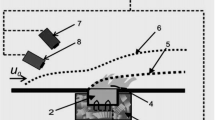Summary
-
1.
Using tungsten-rhenium thermocouples we have obtained a complete temperature distribution for steady-state burning of nitroglycerine powder in the pressure range 5–150 atm at an initial powder temperature of 25° C.
-
2.
We have found the surface temperature of the burning powder TS as a function of pressure. This temperature is 200° C at p=3 atm and 300° C at 10 atm. The rate of growth of TS decreases with pressure. A temperature of 400° C is reached at p=50 atm and 450° C at 120–150 atm.
-
3.
The temperature distribution in the condensed phase is 1.5–2 times broader than the Michelson distribution, which can to a large extent be attributed to the increase in the thermal conductivity of the powder with temperature.
-
4.
The multizonal character of the temperature distribution in the gas phase has been confirmed. With increase in pressure the vapor-smoke-gas zone approaches the surface more slowly than the flame zone.
-
5.
The amount of heat released in the reaction layer of the condensed phase increases from 60 at 5 atm to 130 cal/g at 150 atm. The fraction of heat supplied to the condensed phase from the gas phase is 15–20% of the total amount of heat released in the condensed phase.
-
6.
The heat release in the smoke-gas zone and the flame zone also increases with increase in pressure: in the former from 300 (5 atm) to 360 cal/g (75 atm), in the latter from 220 (20 atm) to 320 cal/g (75 atm).
Similar content being viewed by others
References
R. Klein, M. Mentser, G. Elbe, and B. Lewis, J. Phys. Chem.,54, 4, 877, 1950.
C. A. Heller and A. S. Gordon, J. Phys. Chem.,59, 3, 773, 1955.
L. N. Gal'perin, V. M. Mal'tsev, and P. F. Pokhil, DAN SSSR,127, 1, 131, 1959.
P. F. Pokhil, V. M. Mal'tsev, and G. V. Lukashenya, DAN SSSR,135, 4, 913, 1960.
A. A. Zenin, PMTF, 5, 125, 1963.
Candidate's dissertation, Institute of Physical Chemistry AS USSR, 1962.
P. F. Pokhil, L. D. Romodanova, and M. M. Belov, in: Physics of Explosion [in Russian], Moscow, Izd-vo AN SSSR, no. 3, 1955.
A. A. Zenin, FGV, 1, 74, 1966.
J. Powling and W. A. W. Smith, Combustion and Flame,6, 3, 173, 1962.
C. Huggett, “Combustion of solid propellants,” in: Liquid and Solid Rocket Propellants [collection of Russian translations], ed. Yu. Kh. Shaulov, Moscow, IL, 1959.
R. M. Zaidel and Ya. B. Zel'dovich, PMTF,4, 27, 1962.
R. N. Wimpress, Internal Ballistics of Solid-Fuel Rockets [Russian translation], Moscow, IL, 1952.
P. F. Pokhil and V. M. Mal'tsev, DAN SSSR,132, 3, 646, 1960.
A. A. Zenin, FGV [Combustion, Explosion, and Shock Waves], 2, 28, 1966.
Additional information
Fizika Goreniya i Vzryva, Vol. 2, No. 3, pp. 67–76, 1966
Rights and permissions
About this article
Cite this article
Zenin, A.A. Structure of temperature distribution in steady-state burning of a ballistite powder. Combust Explos Shock Waves 2, 40–45 (1966). https://doi.org/10.1007/BF00749025
Issue Date:
DOI: https://doi.org/10.1007/BF00749025




